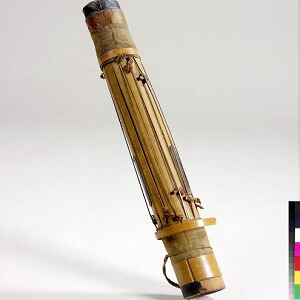Valiha
 The valiha is a tube-zither chordophone of Madagascar. Not all valiha are tube zithers; many have string carriers made in box form from wood or metal, or use repurposed items such as metal mail boxes. The oldest form, however, is that of a tube, as is the case with the two valiha. Originally used solely in ritual settings, it is today heard outside these contexts as well, including in the domain of popular music (listen to second audio clip of the internationally-renown Malagasy group Tarika Sammy). In the past only men played this instrument, but this prohibition is no longer followed even in ritual settings.
The valiha is a tube-zither chordophone of Madagascar. Not all valiha are tube zithers; many have string carriers made in box form from wood or metal, or use repurposed items such as metal mail boxes. The oldest form, however, is that of a tube, as is the case with the two valiha. Originally used solely in ritual settings, it is today heard outside these contexts as well, including in the domain of popular music (listen to second audio clip of the internationally-renown Malagasy group Tarika Sammy). In the past only men played this instrument, but this prohibition is no longer followed even in ritual settings.
The bamboo tubes used for both valiha pictured here have a lengthy middle section articulated by two closed nodes in the bamboo (in detail #1, which is taken from the top end of the gallery #1 instrument, the top node can be seen a few inches in from the lip). The nodes on the gallery #1 valiha, located 3.8 inches down from the top end of the tube and 7.6 inches above the bottom end of the tube, are marked on the instrument’s exterior by leather rings, which cover up the hitch pins--basically small nails--that are pounded into the nodes and serve to anchor the strings to the string carrier (the tube). Two sound holes are drilled into the otherwise totally enclosed center section of the tube .
Considered one of the oldest instruments of Madagascar, the valiha likely is a descendent of similar tube zithers brought to the island from parts of insular Southeast Asia during ancient migrations (see sasandu). Originally, the strings were simply raised lengths of the bamboo tube’s skin, but by the turn of the 20th century metal strings started to be used. The greatest area of innovation over the past century has been with the string carrier--the materials used and its form.